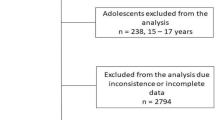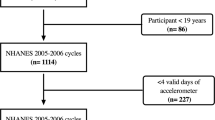Abstract
Background:
Moderate and vigorous physical activity (MVPA) and screen time (ST) have been associated with cardiometabolic health in youth. However, previous studies are conflicting whether these associations are independent of each other and it is unknown if they are modified by adiposity. We aimed to examine the independent and joint associations between MVPA and ST with cardiometabolic risk across body mass index (BMI) categories.
Methods:
A total of 36 956 Brazilian adolescents (12–17 years) from the Study of Cardiovascular Risks in Adolescents were included. Information on time spent in MVPA and ST were assessed by self-reports. Blood pressure, Homeostasis Model Assessment of Insulin Resistance, triglycerides, high-density lipoprotein-cholesterol and waist circumference were used to calculate a cardiometabolic risk score (sex-age-specific top-risk quintile for each biomarker). Ordered logistic regression was used to examine the associations.
Results:
In final adjusted models, both higher MVPA (proportional odds ratio (POR)=0.80; 95% confidence interval (CI): 0.67–0.95) and ST (POR=1.23; 95% CI: 1.10–1.37) were independently associated with cardiometabolic risk. After stratification by normal weight vs overweight/obese, the inverse independent association for MVPA remained unchanged, whereas ST was positively associated with cardiometabolic risk only in overweight/obese adolescents (POR=1.62; 95% CI: 1.18–2.22). Participants who met the recommendations for both MVPA and ST had lower odds for cardiometabolic risk, especially if they were overweight/obese (POR=0.46; 95% CI: 0.31–0.68).
Conclusions:
MVPA and ST are independently associated with cardiometabolic risk; the association with ST, however, appears modified by BMI. Normal-weight adolescents should be encouraged to increase MVPA, whereas a combination of increasing MVPA and decreasing ST is recommended in those who are overweight or obese.
This is a preview of subscription content, access via your institution
Access options
Subscribe to this journal
Receive 12 print issues and online access
$259.00 per year
only $21.58 per issue
Buy this article
- Purchase on Springer Link
- Instant access to full article PDF
Prices may be subject to local taxes which are calculated during checkout
Similar content being viewed by others
References
Ng M, Fleming T, Robinson M, Thomson B, Graetz N, Margono C et al. Global, regional, and national prevalence of overweight and obesity in children and adults during 1980–2013: a systematic analysis for the Global Burden of Disease Study 2013. Lancet 2014; 384: 766–781.
May AL, Kuklina EV, Yoon PW . Prevalence of cardiovascular disease risk factors among US adolescents, 1999-2008. Pediatrics 2012; 129: 1035–1041.
Lim S, Jang HC, Park KS, Cho SI, Lee MG, Joung H et al. Changes in metabolic syndrome in American and Korean youth, 1997–2008. Pediatrics 2013; 131: e214–e222.
Roth GA, Nguyen G, Forouzanfar MH, Mokdad AH, Naghavi M, Murray CJ . Estimates of global and regional premature cardiovascular mortality in 2025. Circulation 2015; 132: 1270–1282.
Palve KS, Pahkala K, Magnussen CG, Koivistoinen T, Juonala M, Kahonen M et al. Association of physical activity in childhood and early adulthood with carotid artery elasticity 21 years later: the cardiovascular risk in Young Finns Study. J Am Heart Assoc 2014; 3: e000594.
Ekelund U, Luan J, Sherar LB, Esliger DW, Griew P, Cooper A . Moderate to vigorous physical activity and sedentary time and cardiometabolic risk factors in children and adolescents. JAMA 2012; 307: 704–712.
Chaput JP, Saunders TJ, Mathieu ME, Henderson M, Tremblay MS, O'Loughlin J et al. Combined associations between moderate to vigorous physical activity and sedentary behaviour with cardiometabolic risk factors in children. Appl Physiol Nutr Metab 2013; 38: 477–483.
Ekelund U, Brage S, Froberg K, Harro M, Anderssen SA, Sardinha LB et al. TV viewing and physical activity are independently associated with metabolic risk in children: the European Youth Heart Study. PLoS Med 2006; 3: e488.
Ullrich-French SC, Power TG, Daratha KB, Bindler RC, Steele MM . Examination of adolescents' screen time and physical fitness as independent correlates of weight status and blood pressure. J Sports Sci 2010; 28: 1189–1196.
Young DR, Hivert M-F, Alhassan S, Camhi SM, Ferguson JF, Katzmarzyk PT et al. Sedentary behavior and cardiovascular morbidity and mortality. Circulation 2016; 134: e262–e279.
Chomistek AK, Manson JE, Stefanick ML, Lu B, Sands-Lincoln M, Going SB et al. Relationship of sedentary behavior and physical activity to incident cardiovascular disease: results from the Women's Health Initiative. J Am Coll Cardiol 2013; 61: 2346–2354.
World Health Organization Global Recommendations on Physical Activity for Health. World Health Organization: Geneva, Switzerland, 2010.
American Academy of Pediatrics.. Children, adolescents, and the media. Pediatrics 2013; 132: 958–961.
Laurson KR, Eisenmann JC, Welk GJ, Wickel EE, Gentile DA, Walsh DA . Combined influence of physical activity and screen time recommendations on childhood overweight. J Pediatr 2008; 153: 209–214.
Eisenmann JC, Bartee RT, Smith DT, Welk GJ, Fu Q . Combined influence of physical activity and television viewing on the risk of overweight in US youth. Int J Obes (Lond) 2008; 32: 613–618.
Bai Y, Chen S, Laurson KR, Kim Y, Saint-Maurice PF, Welk GJ . The associations of youth physical activity and screen time with fatness and fitness: The 2012 NHANES National Youth Fitness Survey. PLoS One 2016; 11: e0148038.
Rendo-Urteaga T, de Moraes AC, Collese TS, Manios Y, Hagstromer M, Sjostrom M et al. The combined effect of physical activity and sedentary behaviors on a clustered cardio-metabolic risk score: The Helena Study. Int J Cardiol 2015; 186: 186–195.
Heshmat R, Qorbani M, Shahr Babaki AE, Djalalinia S, Ataei-Jafari A, Motlagh ME et al. Joint association of screen time and physical activity with cardiometabolic risk factors in a national sample of Iranian adolescents: The CASPIANIII Study. PLoS One 2016; 11: e0154502.
Tarp J, Brønd JC, Andersen LB, Møller NC, Froberg K, Grøntved A . Physical activity, sedentary behavior, and long-term cardiovascular risk in young people: A review and discussion of methodology in prospective studies. J Sport Health Sci 2016; 5: 145–150.
Ekelund U, Ward HA, Norat T, Luan J, May AM, Weiderpass E et al. Physical activity and all-cause mortality across levels of overall and abdominal adiposity in European men and women: the European Prospective Investigation into Cancer and Nutrition Study (EPIC). Am J Clin Nutr 2015; 101: 613–621.
The InterAct Consortium. Physical activity reduces the risk of incident type 2 diabetes in general and in abdominally lean and obese men and women: the EPIC–InterAct Study. Diabetologia 2012; 55: 1944–1952.
Bloch KV, Szklo M, Kuschnir MC, Abreu Gde A, Barufaldi LA, Klein CH et al. The Study of Cardiovascular Risk in Adolescents—ERICA: rationale, design and sample characteristics of a national survey examining cardiovascular risk factor profile in Brazilian adolescents. BMC Public Health 2015; 15: 94.
Vasconcellos MT, Silva PL, Szklo M, Kuschnir MC, Klein CH, Abreu Gde A et al. Sampling design for the Study of Cardiovascular Risks in Adolescents (ERICA). Cad Saude Publica 2015; 31: 921–930.
Silva TL, Klein CH, Souza Ade M, Barufaldi LA, Abreu Gde A, Kuschnir MC et al. Response rate in the Study of Cardiovascular Risks in Adolescents - ERICA. Rev Saude Publica 2016; 50 (Suppl 1): 1s–13s.
Sallis JF, Strikmiller PK, Harsha DW, Feldman HA, Ehlinger S, Stone EJ et al. Validation of interviewer- and self-administered physical activity checklists for fifth grade students. Med Sci Sports Exerc 1996; 28: 840–851.
de Farias Jr JC, Lopes Ada S, Mota J, Santos MP, Ribeiro JC, Hallal PC . Validity and reproducibility of a physical activity questionnaire for adolescents: adapting the Self-Administered Physical Activity Checklist. Rev Bras Epidemiol 2012; 15: 198–210.
Cureau FV, da Silva TL, Bloch KV, Fujimori E, Belfort DR, de Carvalho KM et al. ERICA: leisure-time physical inactivity in Brazilian adolescents. Rev Saude Publica 2016; 50 (Suppl 1): 4s.
Stergiou GS, Yiannes NG, Rarra VC . Validation of the Omron 705 IT oscillometric device for home blood pressure measurement in children and adolescents: the Arsakion School Study. Blood Press Monit 2006; 11: 229–234.
de Onis M, Onyango AW, Borghi E, Siyam A, Nishida C, Siekmann J . Development of a WHO growth reference for school-aged children and adolescents. Bull World Health Organ 2007; 85: 660–667.
Associação Brasileira de Empresas de Pesquisa (ABEP). Critério de classificação econômica Brasil, 2013. Available at: http://www.abep.org/criterio-brasil (last accessed 14 September 2015).
Warren CW, Jones NR, Peruga A, Chauvin J, Baptiste JP, Costa de Silva V et al. Global youth tobacco surveillance, 2000–2007. MMWR Surveill Summ 2008; 57: 1–28.
Williams R . Generalized ordered logit/partial proportional odds models for ordinal dependent variables. Stata J 2006; 6: 58–82.
Fullerton AS . A conceptual framework for ordered logistic regression models. Sociol Method Res 2009; 38: 306–347.
Szklo M, Javier Nieto F . Epidemiology Beyond the Basics, 2nd edn. Jones & Bartlett Publishers: Burlington, MA, USA, 2007.
Wennberg P, Gustafsson PE, Howard B, Wennberg M, Hammarstrom A . Television viewing over the life course and the metabolic syndrome in mid-adulthood: a longitudinal population-based study. J Epidemiol Community Health 2014; 68: 928–933.
Zhang G, Wu L, Zhou L, Lu W, Mao C . Television watching and risk of childhood obesity: a meta-analysis. Eur J Public Health 2015; 26: 13–18.
Andersen LB, Harro M, Sardinha LB, Froberg K, Ekelund U, Brage S et al. Physical activity and clustered cardiovascular risk in children: a cross-sectional study (The European Youth Heart Study). Lancet 2006; 368: 299–304.
Lipsky LM, Iannotti RJ . Associations of television viewing with eating behaviors in the 2009 Health Behaviour in School-aged Children Study. Arch Pediatr Adolesc Med 2012; 166: 465–472.
Thosar SS, Bielko SL, Mather KJ, Johnston JD, Wallace JP . Effect of prolonged sitting and breaks in sitting time on endothelial function. Med Sci Sports Exerc 2015; 47: 843–849.
Cleland VJ, Schmidt MD, Dwyer T, Venn AJ . Television viewing and abdominal obesity in young adults: is the association mediated by food and beverage consumption during viewing time or reduced leisure-time physical activity? Am J Clin Nutr 2008; 87: 1148–1155.
de Moraes AC, Carvalho HB, Rey-Lopez JP, Gracia-Marco L, Beghin L, Kafatos A et al. Independent and combined effects of physical activity and sedentary behavior on blood pressure in adolescents: gender differences in two cross-sectional studies. PLoS One 2013; 8: e62006.
Acknowledgements
ERICA project was supported by Funding Authority for Studies and Projects (FINEP) (grant: 01090421); Brazilian National Counsel of Technological and Scientific Development (CNPq) (grants: 565037/2010-2, 405009/2012-7 and 457050/2013-6). FVC is supported by Coordenação de Aperfeiçoamento de Pessoal de Nível Superior (CAPES) with sandwich PhD scholarship (process: BEX 9556/14-1). KVB (process: 304595/2012-8) and BS (process: 305116/2012-6) were partially supported by CNPq. UE was partly funded by the UK Medical Research Council Grant MC_UU_2015/3 and by the Norwegian Research Council (249932/F20).
Author information
Authors and Affiliations
Corresponding author
Ethics declarations
Competing interests
The authors declare no conflict of interest.
Additional information
Supplementary Information accompanies this paper on International Journal of Obesity website
Supplementary information
Rights and permissions
About this article
Cite this article
Cureau, F., Ekelund, U., Bloch, K. et al. Does body mass index modify the association between physical activity and screen time with cardiometabolic risk factors in adolescents? Findings from a country-wide survey. Int J Obes 41, 551–559 (2017). https://doi.org/10.1038/ijo.2016.210
Received:
Revised:
Accepted:
Published:
Issue Date:
DOI: https://doi.org/10.1038/ijo.2016.210
This article is cited by
-
Prolonged screen watching behavior is associated with high blood pressure among children and adolescents: a systematic review and dose–response meta-analysis
Journal of Health, Population and Nutrition (2023)
-
Television viewing time and all-cause mortality: interactions with BMI, physical activity, smoking, and dietary factors
International Journal of Behavioral Nutrition and Physical Activity (2022)
-
Exercise training maintains cardiovascular health: signaling pathways involved and potential therapeutics
Signal Transduction and Targeted Therapy (2022)
-
Relationship between sleep duration and TV time with cardiometabolic risk in adolescents
Environmental Health and Preventive Medicine (2020)



